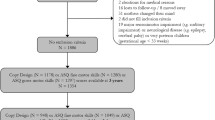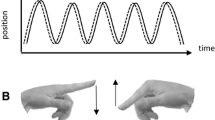Abstract
Severely quadraplegic cerebral-palsied children suffer profound deprivation of early sensorimotor experiences considered by Piagetian theory as critical to the development of cognitive structures. In the present study, 34 children quadraplegic from birth, ranging in age from 9 months to 12 years, were tested for level of object permanence which, according to Piaget, signals the emergence of mental representation. Sixteen demonstrated high levels of object permanence. Severity of physical handicap accounted for less than 15% of the variation in scores. With severity held constant, mental age explained 25% of the variance. These results indicate that early cognitive milestones can be achieved by children severely physically handicapped since birth and that general intellectual level may be more important than severity of the motor handicap in determining such achievement.
Similar content being viewed by others
References
American Medical Association (1965).Mental retardation handbook.
Eagle, R. S. (in press). The role of motivation-related variables in assessment of intellectual potential in severely involved quadraplegic children.Journal of Autism and Developmental Disorders.
Eagle, R. S., Struening, E., & Milcarek, B. (1983)Evaluation of intelligence in severely involved quadraplegic children: The effects of type of test, home, and education experience on the change in IQ scores. Submitted for publication.
Gordon, R., Gitler, D., Schwartz, B., & Esrachi, O. (1976).Evaluation of behavioral change, Part I: Study of multi-handicapped young children, Final Report. Washington, D.C.: United States Department of Health, Education and Welfare, Project No. H00505J, Grant No. OEG-0-72-5386.
Gouin-Decarie, T. (1969). A study of the mental and emotional development of the thalidomide child. In B. Foss (Ed.),Determinants of infant behavior, (Vol. 4), (pp. 167–187), London: Methuen.
Haeussermann, E. (1958). Developmental potential of preschool children:An evaluation of intellectual, sensory, and emotional functioning. New York: Gruen & Stratton.
Hoffman, H. (1975).Bayley scales of infant development: Modifications for youngsters with handicapping conditions. Long Island, New York: Suffolk Rehabilitation Center. Unpublished.
Holden, R. H. (1952). A review of psychological studies of cerebral palsy, 1947–1952.American Journal of Mental Deficiency, 56, 92–98.
Inhelder, B. (1968).The diagnosis of reasoning in the mentally retarded. New York: John Day.
Kahn, J. V. (1975). The utility of the Uzgiris and Hunt scales of sensorimotor development with severely and profoundly retarded children.American Journal of Mental Deficiency, 79, 640–643.
Kershner, J. R. (1974). Relationship of motor development to visual-spatial cognitive growth.Journal of Special Education, 8(1), 91–102.
Kopp, C. B., & Schaferman, J. (1973). Cognition in absence of manipulation.Developmental Psychology, 9, 430.
O'Connor, N. (1973). The experimental contribution to learning problems in the retarded. In D. K. Routh (Ed.),The experimental psychology of mental retardation (pp. 18–41). Chicago: Aldine.
Piaget, J. (1952).The origins of intelligence. New York: International Universities Press.
Robinault, I. P. (1954). Perception techniques for the preschool cerebral palsied child.American Journal of Occupational Therapy.8(1), 3–5.
Robinson, M., & Tatnell, I. (1968). Intellectual functioning of children with congenital amputation.Clinical Proceedings of the Children's Hospital, 24(1), 100–107.
Salek, B. (1977).Movement learning in the cerebral palsy child. Long Island New York: Suffolk Rehabilitation Center. Unpublished.
Saunders, R. V. (1915). Educational disabilities of cerebral palsy children attending local education authority schools.Cerebral Palsy Bulletin, 5, 16–19.
Segalowitz, S. J. (1980). Piaget's Achille's Heel: A safe soft spot?Human Development, 23, 137–140.
Shere, E., & Kastenbaum, R. (1966). Mother-child interaction in cerebral palsy: Environmental and psychosocial obstacle to cognitive development.Genetic Psychology Monographs, 73, 255–335.
Sheridan, M. D. (1962). Mentally handicapped children.Developmental Medicine and Child Neurology, 4, 71–76.
Uzgiris, I. C., & Hunt, J. McV (1966).An instrument for assessing infant psychological development. University of Illinois. Unpublished.
Wedell, K. (1960). The visual perception of cerebral palsy children.Journal of Child Psychology and Psychiatry, 1, 215–227.
Woodward, M. (1959). The behavior of idiots interpreted by Piaget's theory of sensorimotor development.British Journal of Educational Psychology, 29, 69–71.
Author information
Authors and Affiliations
Additional information
This study is part of a larger research project conceived and carried out between 1974 and 1976, during a two-year NIMH postdoctoral research fellowship (#5 F22 MH 0279002), New York University Medical Center, in New York City, under the direction of Leonard Diller, Ph.D. After termination of the fellowship, the data analysis was performed at Columbia University Computer Center, and was supported by the Epidemiology of Mental Disorders Research Department, Psychiatric Institute, under the direction of Elmer Struening. I am very grateful to Dr. Struening, for his generous support and direction of the statistical treatment of the data, and to Drs. Barry I. Milcarek and Bruce Link for their assistance in computer programming. I also wish to express my appreciation to the directors, teachers, and children of the United Cerebral Palsy Schools for their interest and splendid cooperation during the two years of testing at these centers.
Rights and permissions
About this article
Cite this article
Eagle, R.S. Deprivation of early sensorimotor experience and cognition in the severely involved cerebral-palsied child. J Autism Dev Disord 15, 269–283 (1985). https://doi.org/10.1007/BF01531498
Issue Date:
DOI: https://doi.org/10.1007/BF01531498




